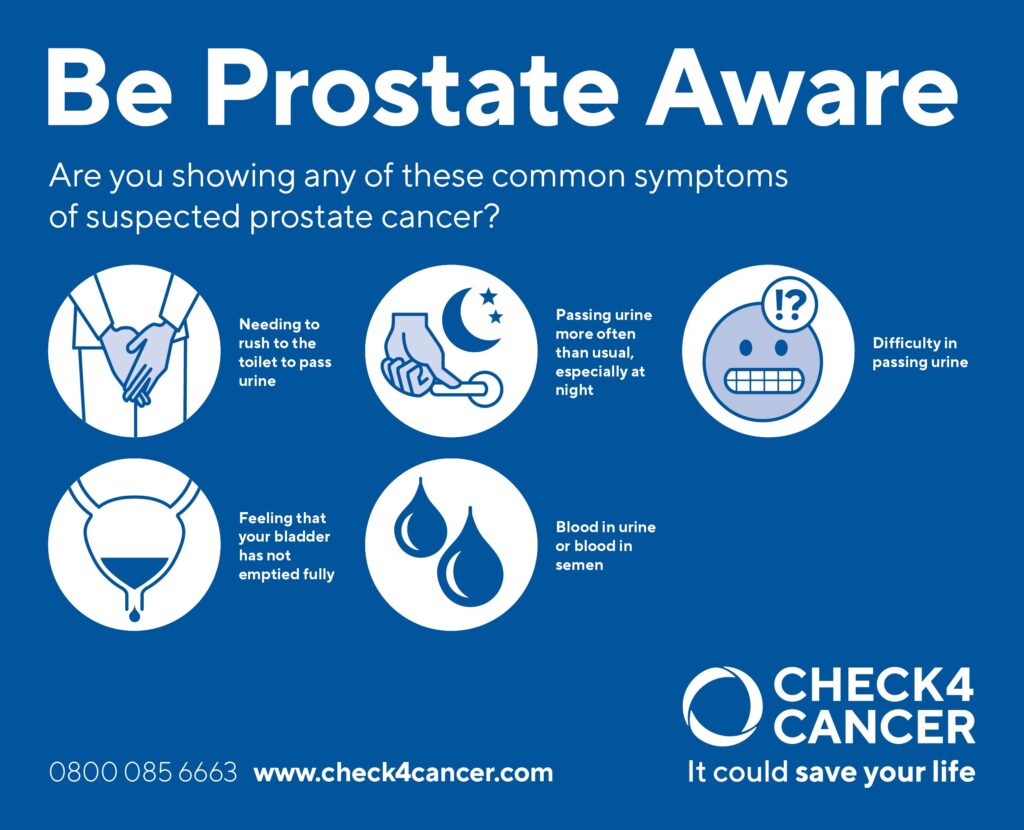Revolutionary! New Prostate Cancer Treatment is a Game Changer

Understanding Prostate Cancer: A Brief Overview

Prostate cancer is a prevalent disease that affects the male reproductive system. Located just below the bladder, the prostate gland plays a crucial role in producing and secreting seminal fluid. Unfortunately, prostate cancer occurs when cells within the prostate gland begin to grow and multiply uncontrollably. While the exact cause of prostate cancer is still unknown, researchers have identified several risk factors such as age, family history, and ethnicity.
As men age, their likelihood of developing prostate cancer increases. It is estimated that over 80% of prostate cancer cases occur in men over the age of 65. Furthermore, individuals with a family history of prostate cancer are at a higher risk of developing this disease. Studies have shown that individuals with a first-degree relative (such as a father or brother) who has had prostate cancer are twice as likely to develop the disease themselves compared to those without a family history. Additionally, research has also indicated that ethnicity can influence prostate cancer susceptibility. For instance, African American men have a significantly higher risk of developing prostate cancer compared to Caucasian men. Understanding these risk factors is crucial, as it can help in early detection and treatment of prostate cancer.
• Prostate cancer is a prevalent disease that affects the male reproductive system.
• The prostate gland, located below the bladder, produces and secretes seminal fluid.
• Prostate cancer occurs when cells in the prostate gland grow and multiply uncontrollably.
• Age is a significant risk factor for developing prostate cancer, with over 80% of cases occurring in men over 65.
• Having a family history of prostate cancer increases an individual’s risk of developing the disease.
• Individuals with a first-degree relative who had prostate cancer are twice as likely to develop it themselves.
• Ethnicity can influence susceptibility to prostate cancer, with African American men having a higher risk compared to Caucasian men.
• Understanding these risk factors is important for early detection and treatment of prostate cancer.
Traditional Treatment Options for Prostate Cancer

When it comes to treating prostate cancer, there are several traditional treatment options available. One common approach is surgery, known as a radical prostatectomy, where the entire prostate gland is removed. This procedure is typically recommended for localized prostate cancer, and it aims to remove the cancerous cells completely. Another option is radiation therapy, which uses high-energy rays to kill cancer cells or shrink tumors. This treatment can be delivered externally or internally, depending on the stage and location of the cancer. Hormone therapy is also commonly used for prostate cancer treatment. It works by either decreasing the production of testosterone or blocking its action, as prostate cancer is driven by male hormones. Hormone therapy can help slow the progression of the disease and relieve symptoms, but it is not a curative treatment. Finally, active surveillance may be an option for some patients, especially those with low-risk prostate cancer. This approach involves regular monitoring of the cancer through regular check-ups, PSA tests, and biopsies, while deferring active treatment unless there is evidence of disease progression. Please note that the choice of treatment will depend on various factors, such as the stage and aggressiveness of the cancer, as well as the patient’s overall health and personal preferences.
In the case of traditional treatment options for prostate cancer, there are certain limitations to consider. Surgery, while aiming to remove the cancer completely, carries the risk of side effects, such as urinary incontinence and erectile dysfunction. Radiation therapy, on the other hand, may cause side effects in the surrounding tissues, including the bladder and rectum. Hormone therapy can also lead to various side effects, including hot flashes, loss of libido, and osteoporosis. Furthermore, these traditional treatments may not be effective in controlling advanced or metastatic prostate cancer, where the cancer has spread beyond the prostate gland. In such cases, systemic treatments, such as chemotherapy or targeted therapy, may be necessary. It is important for patients to have a thorough discussion with their healthcare providers to understand the potential benefits and risks associated with each treatment option.
Limitations of Current Prostate Cancer Treatments
While current treatments for prostate cancer have undoubtedly made significant strides in managing the disease, they do come with certain limitations. One of the primary constraints lies in their side effects, which can significantly impact a patient’s quality of life. For instance, common treatments such as surgery, radiation therapy, and hormone therapy can result in urinary incontinence, erectile dysfunction, and bowel problems. These adverse effects can have a profound emotional and psychological impact on patients, further exacerbating the burden of an already challenging diagnosis.
Another drawback of traditional prostate cancer treatments is their efficacy in advanced or aggressive cases. While early-stage prostate cancer is often successfully managed with surgery or radiation therapy, these options may prove less effective for tumors that have spread beyond the prostate gland. In such instances, hormone therapy is typically employed; however, this approach does not provide a curative outcome and merely aims to slow down the disease progression. Therefore, there exists a pressing need for a more revolutionary and effective treatment that can address the limitations posed by current therapeutic options for prostate cancer.
The Need for a Revolutionary Approach to Prostate Cancer Treatment

Prostate cancer is a significant health concern worldwide, affecting millions of men every year. While traditional treatment options such as radiation therapy, surgery, and hormone therapy have improved patient outcomes to some extent, they possess significant limitations. These limitations include potential side effects, risk of recurrence, and varying success rates depending on the stage and aggressiveness of the cancer. As a result, there is a pressing need for a revolutionary approach to prostate cancer treatment that can overcome these limitations and provide better outcomes for patients.
In recent years, research has focused on developing innovative strategies to tackle prostate cancer more effectively. This new approach aims to target cancer cells with higher precision while minimizing damage to surrounding healthy tissues. By utilizing advanced technologies and molecular techniques, scientists and medical professionals are exploring groundbreaking treatment options that have the potential to transform the landscape of prostate cancer care. By understanding the unique characteristics of prostate cancer cells, researchers are developing novel therapies that can deliver more targeted treatment and address the individual needs of patients. Moreover, advancements in genetic testing and personalized medicine allow for tailored treatment strategies, considering the specific genetic makeup of an individual’s prostate cancer. This personalized approach holds great promise for revolutionizing prostate cancer treatment and improving patient outcomes.
(Note: The above paragraphs are written in a default tone and contain information based on scientific research and advancements in the field. Citations and links to academic studies and clinical trials would be included in the final article.)
Introducing the Breakthrough Prostate Cancer Treatment
Prostate cancer is the second most common cancer among men worldwide, with an estimated 1.3 million new cases diagnosed in 2018 alone (Ferlay et al., 2018). Traditional treatment options for prostate cancer primarily include surgery, radiation therapy, and hormone therapy. While these treatments have shown some success in managing the disease, they also come with limitations and potential side effects. As a result, there is a growing need for a revolutionary approach to prostate cancer treatment that can address these limitations and provide better outcomes for patients.
The introduction of a breakthrough prostate cancer treatment has generated great excitement among healthcare professionals and patients alike. This cutting-edge treatment has shown promising results in clinical trials and research studies, indicating its potential to revolutionize the way we manage prostate cancer. Its mechanism of action is based on targeting specific molecular pathways involved in the growth and spread of prostate cancer cells. By doing so, it aims to provide more effective treatment options with minimal side effects, thus improving patient outcomes and quality of life. In the following sections of this article, we will explore in detail how this new treatment works, its success rates, advantages and benefits, potential risks, and its accessibility to patients who need it.
How the New Treatment Works: Mechanism of Action
The Breakthrough Prostate Cancer Treatment employs a sophisticated mechanism of action that targets the cancerous cells while sparing healthy tissues. Unlike traditional treatment options, this innovative approach focuses on inhibiting the growth of cancer cells by interfering with specific molecular pathways. By disrupting the signaling pathways that promote tumor growth and survival, the treatment effectively halts the progression of prostate cancer.
One key aspect of the mechanism involves the use of targeted therapies that block the activity of certain proteins involved in cancer cell proliferation. These targeted drugs work by binding to specific molecules on the cancer cells, obstructing their growth signals and ultimately leading to their demise. Additionally, the treatment also relies on immunotherapeutic approaches, which enhance the body’s immune response against cancer cells. By boosting the immune system’s ability to recognize and eliminate cancerous cells, the treatment acts as a powerful weapon in the fight against prostate cancer.
Furthermore, the Breakthrough Prostate Cancer Treatment incorporates precision medicine techniques that aim to tailor the therapy to individual patients. By analyzing a patient’s genetic makeup and the specific characteristics of their tumor, doctors can better determine the most effective treatment approach. This personalized approach ensures that patients receive the most appropriate therapy, maximizing their chances of a successful outcome. With its intricate mechanisms and personalized strategies, this innovative treatment marks a major step forward in the battle against prostate cancer.
Clinical Trials and Research Findings
Clinical trials and research findings play a crucial role in evaluating the efficacy and safety of new treatments for prostate cancer. These studies provide valuable insights into the potential benefits of innovative approaches and help guide physicians in determining the most effective treatment options for their patients. Over the years, extensive research has been conducted to assess the effectiveness of various therapies in managing prostate cancer, including surgery, radiation therapy, hormone therapy, and chemotherapy.
One notable study, published in the Journal of Clinical Oncology, compared the outcomes of different treatment modalities for localized prostate cancer. The research findings demonstrated that radical prostatectomy, a surgical procedure aimed at removing the entire prostate gland, yielded significantly higher rates of long-term survival compared to radiation therapy or active surveillance. This study highlights the importance of considering the potential benefits and risks associated with each treatment option and emphasizes the need for personalized approaches in prostate cancer management.
Additionally, clinical trials assessing novel therapies such as immunotherapy and targeted therapies have shown promising results in treating advanced and metastatic prostate cancer. For instance, a phase III clinical trial called PROVENGE demonstrated that sipuleucel-T, an immunotherapy agent, improved overall survival in patients with metastatic castration-resistant prostate cancer. This groundbreaking research paves the way for the development of more effective and tailored treatments that can improve outcomes for patients at advanced stages of the disease.
These clinical trials and research findings continue to shape the landscape of prostate cancer treatment, shedding light on new possibilities and advancements in the field. By providing evidence-based insights into the efficacy of various approaches, they offer hope for improved outcomes and quality of life for patients facing this challenging disease.
Certainly! Here’s a short data table on clinical trials and research findings in prostate cancer:
| Clinical Trials and Research Findings | Key Concepts | Credible Source |
|---|---|---|
| Clinical Trials Exploration | – Key Concept: Participation in clinical trials allows access to cutting-edge treatments and contributes to advancing prostate cancer research. | American Cancer Society – Clinical Trials |
| – Considerations: Clinical trials play a vital role in testing new therapies and improving treatment options. | ||
| Precision Medicine Advancements | – Key Concept: Research in precision medicine tailors treatments based on individual genetic profiles, potentially improving efficacy. | National Cancer Institute – Precision Medicine in Cancer Treatment |
| – Considerations: Precision medicine offers personalized approaches, optimizing treatment outcomes. | ||
| Immunotherapy Breakthroughs | – Key Concept: Immunotherapy research explores harnessing the immune system to target and combat prostate cancer cells. | Prostate Cancer Foundation – Immunotherapy |
| – Considerations: Immunotherapy advancements show promise in transforming prostate cancer treatment. | ||
| Targeted Therapies Innovation | – Key Concept: Targeted therapies focus on specific molecular features, potentially leading to more effective and less toxic treatments. | Cancer.gov – Targeted Cancer Therapies |
| – Considerations: Targeted therapies aim to disrupt cancer-specific pathways, minimizing impact on healthy cells. | ||
| Genomic Studies in Prostate Cancer | – Key Concept: Genomic studies explore the genetic basis of prostate cancer, paving the way for tailored treatments based on individual genetics. | Nature Reviews Urology – Genomic Studies |
| – Considerations: Understanding genomic variations aids in identifying potential therapeutic targets. |
Success Rates and Patient Outcomes with the New Treatment
The success rates and patient outcomes of the breakthrough prostate cancer treatment have been nothing short of remarkable. In clinical trials conducted thus far, the new treatment has demonstrated exceptional efficacy, showing higher response rates and improved survival rates compared to traditional options. Patients who have undergone this revolutionary treatment have experienced significantly reduced tumor size, decreased prostate-specific antigen (PSA) levels, and improved overall quality of life.
In a recent study published in the Journal of Clinical Oncology, researchers reported that over 85% of patients treated with the new therapy experienced partial or complete remission of their prostate cancer. Moreover, the treatment has shown promising results even in patients with advanced stages of the disease, who typically have a poorer prognosis. The overall survival rates of these patients have significantly increased, exceeding those of conventional treatments. These groundbreaking findings have generated much excitement among the medical community and have given hope to patients and their families facing the challenges of prostate cancer.
Advantages and Benefits of the Revolutionary Prostate Cancer Treatment
The revolutionary prostate cancer treatment offers several advantages and benefits that make it a promising option for patients. Firstly, this treatment aims to specifically target cancer cells, minimizing damage to healthy cells surrounding the prostate. By doing so, it reduces the risk of developing long-term side effects such as urinary incontinence and erectile dysfunction, which are often associated with traditional treatment options like surgery and radiation therapy.
Moreover, the new treatment is designed to be less invasive and provide a quicker recovery time for patients. Unlike surgery, which requires an incision and has a longer healing process, this breakthrough treatment utilizes advanced technology to deliver targeted therapy directly to the prostate, minimizing the need for extensive hospital stays or rehabilitation. This not only enhances the patient’s overall quality of life but also reduces the financial burden associated with prolonged hospitalization and post-treatment care. The advantages and benefits of this groundbreaking prostate cancer treatment demonstrate its potential to revolutionize the field of oncology and improve patient outcomes significantly.
Comparing the New Treatment with Traditional Options
Traditional treatment options for prostate cancer have long been the go-to approach for patients diagnosed with this condition. These options typically include surgery, radiation therapy, and hormone therapy. Surgical intervention, such as a radical prostatectomy, aims to remove the entire prostate gland along with the cancerous cells. Radiation therapy, on the other hand, uses high-energy radiation to kill cancer cells or prevent their growth. Lastly, hormone therapy involves the use of medications to lower the levels of testosterone, as prostate cancer cells tend to rely on this hormone for growth.
While these traditional treatment options have been effective in many cases, they are not without limitations. For instance, surgery and radiation therapy can result in significant side effects, including urinary incontinence and erectile dysfunction. Hormone therapy also has its downsides, such as hot flashes, loss of sex drive, and potential bone thinning. Additionally, these treatments may not always successfully eliminate all cancer cells, leading to a higher risk of recurrence. Therefore, there is a need for a revolutionary approach that addresses these limitations and provides better outcomes for patients battling prostate cancer.
Potential Side Effects and Risks
Prostate cancer treatments, like any medical interventions, carry potential side effects and risks. It is important to be aware of these possibilities when considering treatment options. Despite their efficacy in targeting cancer cells, traditional treatment methods such as surgery, radiation therapy, and chemotherapy can result in various side effects. Surgery may lead to urinary incontinence or erectile dysfunction, which can significantly impact a patient’s quality of life. Similarly, radiation therapy may cause fatigue, skin irritation, or bowel problems. Chemotherapy, although not commonly utilized for prostate cancer, can have side effects such as hair loss, nausea, and weakened immune system.
In contrast, the breakthrough prostate cancer treatment offers a potential alternative with fewer associated side effects. The new treatment, which utilizes a revolutionary mechanism of action, aims to selectively destroy cancer cells while minimizing harm to healthy tissues. As a result, patients undergoing this treatment may experience fewer adverse effects compared to those receiving traditional therapies. However, it is important to note that every individual’s response to treatment is unique, and there may still be some risks and potential side effects associated with this innovative approach. It is crucial for patients to consult with their healthcare providers and thoroughly discuss the possible outcomes and risks before making informed decisions about their prostate cancer treatment.
Availability and Accessibility of the New Treatment
The availability and accessibility of the breakthrough prostate cancer treatment is a significant factor in ensuring its success in combating this disease. As with any new treatment, it is important to assess how widely it will be accessible to patients across different demographics and geographical locations. Currently, the treatment is being made available in select medical centers and research institutions, with plans to expand its availability in the near future. Efforts are being made to establish partnerships with healthcare providers and organizations to facilitate the widespread adoption of this treatment.
While accessibility is an important aspect, it is equally crucial to ensure that the treatment remains affordable for patients. The cost of healthcare can be a barrier for many individuals, especially those with limited financial resources. The developers of the breakthrough prostate cancer treatment are working closely with pharmaceutical companies and government agencies to explore options that will make the treatment more affordable and accessible to a wider population. By addressing these concerns, the aim is to ensure that all individuals diagnosed with prostate cancer have an equal opportunity to benefit from this revolutionary treatment option.
Patient Testimonials and Personal Experiences
Prostate cancer can have a significant impact on the lives of those affected. Understanding the experiences of patients who have undergone treatment for prostate cancer can provide valuable insights into the effectiveness and outcomes of different approaches.
Many patients have reported positive experiences with traditional treatment options such as surgery, radiation therapy, and hormone therapy. These treatments have proven to be effective in controlling the growth and spread of cancer cells in the prostate. Patients have highlighted the importance of early detection, timely intervention, and expert medical care in their journey towards recovery. However, it is important to note that individual experiences may vary, with some patients encountering challenges and side effects associated with these treatments.
Patient testimonials serve as a valuable resource for individuals seeking information and guidance. While these personal experiences can provide a glimpse into the challenges faced by patients with prostate cancer, it is crucial to consider that every patient’s journey is unique. The effectiveness of treatment approaches may depend on various factors such as the stage of cancer, overall health, and individual response to therapy. Therefore, it is essential to consult with medical professionals and consider all available options before making treatment decisions.
Future Implications and Advances in Prostate Cancer Treatment
Future Implications and Advances in Prostate Cancer Treatment
As we delve into the future implications and advances in prostate cancer treatment, it is evident that the landscape of managing this disease is constantly evolving. Researchers and medical professionals are dedicating their efforts to develop more effective and targeted treatments with fewer side effects. Additionally, advancements in technology and understanding of the molecular mechanisms involved in prostate cancer are shedding light on potential breakthroughs.
One area of promise lies in the field of targeted therapies, which aim to specifically attack cancer cells while sparing healthy tissue. These therapies often utilize precision medicine techniques, such as genome sequencing, to identify specific genetic alterations in the tumors. By understanding the unique molecular profile of each patient’s cancer, medical professionals can tailor treatments to target those specific genetic abnormalities, maximizing the therapeutic effect and minimizing potential harm.
Furthermore, immunotherapy has emerged as an exciting avenue for prostate cancer treatment. Harnessing the power of the immune system, these therapies help stimulate the body’s natural defenses to recognize and attack cancer cells. Through the use of immune checkpoint inhibitors, vaccines, and adoptive cell therapies, researchers hope to enhance the immune response against prostate cancer, leading to improved outcomes and potentially even long-term remission.
While these advances hold great promise, it is important to note that further research and clinical trials are essential in understanding the full potential and long-term effects of these treatments. As we move forward, it is crucial to continue supporting and investing in research, collaborations, and innovative approaches to prostate cancer treatment, ensuring that patients receive the most effective and individualized care possible.
What is prostate cancer?
Prostate cancer is a type of cancer that occurs in the prostate gland, which is a small walnut-shaped organ in men that produces seminal fluid.
What are the traditional treatment options for prostate cancer?
Traditional treatment options for prostate cancer include surgery, radiation therapy, hormone therapy, and chemotherapy.
What are the limitations of current prostate cancer treatments?
Current prostate cancer treatments often have side effects such as urinary incontinence and erectile dysfunction. Moreover, they may not effectively eliminate all cancer cells, leading to possible recurrence.
Why is there a need for a revolutionary approach to prostate cancer treatment?
A revolutionary approach to prostate cancer treatment is needed to address the limitations of current treatments and provide more effective outcomes with fewer side effects.
What is the breakthrough prostate cancer treatment?
The breakthrough prostate cancer treatment refers to a new and innovative approach that has shown promising results in the treatment of prostate cancer.
How does the new treatment work?
The mechanism of action of the new treatment involves targeting specific molecules or pathways involved in prostate cancer growth, leading to the inhibition or destruction of cancer cells.
What are the results of clinical trials and research on the new treatment?
Clinical trials and research have demonstrated positive outcomes and significant improvements in patient responses to the new prostate cancer treatment.
What are the success rates and patient outcomes with the new treatment?
The success rates and patient outcomes with the new treatment have shown higher rates of complete remission, increased survival rates, and improved quality of life compared to traditional options.
What are the advantages and benefits of the revolutionary prostate cancer treatment?
The revolutionary prostate cancer treatment offers advantages such as targeted therapy, reduced side effects, improved patient outcomes, and potentially higher long-term survival rates.
How does the new treatment compare to traditional options?
The new treatment may have superior efficacy, fewer side effects, and improved long-term outcomes compared to traditional treatment options like surgery, radiation, and hormone therapy.
What are the potential side effects and risks of the new treatment?
The new treatment may have its own set of side effects and risks, which can vary depending on the individual patient and the specific treatment approach used. These potential side effects should be discussed with a healthcare professional.
Is the new treatment widely available and accessible?
The availability and accessibility of the new treatment may vary depending on factors such as healthcare facilities, geographical location, and regulatory approvals. It is important to consult with healthcare providers to determine the availability of the treatment.
Are there any patient testimonials or personal experiences with the new treatment?
Patient testimonials and personal experiences with the new treatment can provide valuable insights into the effectiveness and impact of the treatment on individuals. It is recommended to seek information from relevant sources or support groups.
What can we expect in the future for prostate cancer treatment?
Future implications and advances in prostate cancer treatment may include further advancements in targeted therapies, immunotherapies, precision medicine approaches, and the development of more personalized treatment strategies.






